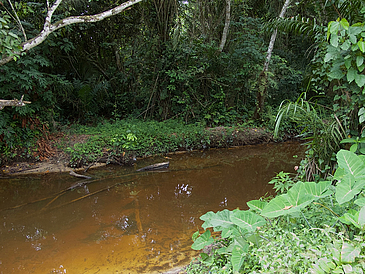About half of the carbon dioxide that is produced by humankind, and which plays an important role in global warming, is taken up by seas and oceans. In addition to the oceans, however, large tropical river systems can also store substantial amounts of carbon, which are released when the climate changes. This has been verified in a new scientific publication by Dr. Enno Schefuß of MARUM, the Center for Marine Environmental Sciences at the University of Bremen, who studied an older sediment core using advanced methods. Results of the work by Schefuß and his team have been published in the journal Nature Geoscience.
In the warm and humid environments of the tropics, such as the rain forests, plants take up a large amount of carbon dioxide (CO2). At the same time, microbial activity in the soil is very pronounced under these conditions, which means that organic material is rapidly broken down again and converted back to CO2. Thus, in marine sediments directly offshore from tropical river estuaries no aged plant material should actually be deposited. At least this has been generally assumed so far, according to Dr. Enno Schefuß.
The sediment core investigated, however, comprising deposits off the mouth of the Congo River, contains some very old organic material. Using radiocarbon methods, the scientists have determined the age of molecular fossils, which are specific chemical components of plants, and of microscopically small wood particles. “The organic components were much older than the depositional age of the sediments, which surprised us at first,” says Schefuß. The core was retrieved during an expedition in 2002 and was studied using highly sophisticated analytical methods. Only the topmost, or youngest, sample from the core showed a relatively young age. The reason for this, according to Schefuß, was atmospheric nuclear testing carried out through the year 1963. These drastically increased the content of atmospheric radioactive carbon (14C), which is used to determine the age. “These high 14C levels overprint all modern samples,” explains the geoscientist, “and the true age is masked by this effect.” So the rivers actually transport older organic material, whose true age is simply not detected. “This fact changes our view of the carbon cycle.”
Hot on the heels of 3.000 year-old organic material
But where does the old organic material come from? The wood particles, for example, which were 3,000 years old when they were deposited? “We found a systematic relationship between age and humidity,” says Schefuß. Even under the relatively dry present-day conditions in the Congo, the conversion processes occur rapidly. It is thus impossible that they are directly regulated by humidity. It can only be explained, in fact, by a different source, which releases carbon when aridity increases.
Special analytical techniques by the English colleagues helped in answering this question. In the samples, the remains of specific, methane-consuming bacteria were discovered, which provided the crucial evidence: the Congo Basin is not completely covered by rain forest. In the center, where several tributaries flow into the Congo, there is an area that is continuously covered by water like a swamp. “The area is about the size of Switzerland and was relatively unknown until recently because it is hidden beneath a dense forest. All of the organic material that goes into the swamp remains fairly well preserved under the oxygen-free conditions. The methane oxidizers live here,” explains Schefuß. The study suggests that the swamp must have been significantly larger in the past. As it dried out the old organic material was released. “What we see in the sediment record, in the stable components that survived decay and transport, are merely the indicators of large CO2 releases,” says Schefuß. The significantly greater portion of released carbon goes directly into the atmosphere as CO2. “This illustrates the fact that wetland areas in tropical river systems are an important storehouse for carbon. If they dry out, either by natural causes or human activity, CO2 is released,” summarizes Schefuß. The Bremen geochemist is convinced that, in the future, the role of tropical wetland areas will have to be more persistently considered in CO2 models. The new interpretation of these data could also serve as a model for comparable areas, such as the Amazon.
Furthermore, the study highlights the importance of sediment cores from the sea floor as climate archives. “There are no climate archives on land that can record these processes. In the areas that dry out the material is transported away. In the remaining swamp areas the material continues to be conserved,” stresses Schefuß. These processes can only be observed offshore near river mouths, where the released stable organic material is finally deposited. “Climate fluctuations in the past thus serve as natural experiments to help us better assess the impacts of the current climate change.”
Publication:
Enno Schefuß, Timothy I. Eglinton, Charlotte L. Spencer-Jones, Jürgen Rullkötter,
Ricardo De Pol-Holz, Helen M. Talbot, Pieter M. Grootes, Ralph R. Schneider: Hydrologic control of carbon cycling and aged carbon discharge in the Congo River basin.
Published in: Nature Geoscience, DOI: 10.1038/ngeo2778
Contact:
Dr. Enno Schefuß
Telephone: +49 421 218-65526
E-Mail: eschefussprotect me ?!marumprotect me ?!.de
Further information / photo material:
Ulrike Prange
MARUM Public Relation
Telefon: +49 421 218-65540
E-Mail: medienprotect me ?!marumprotect me ?!.de

